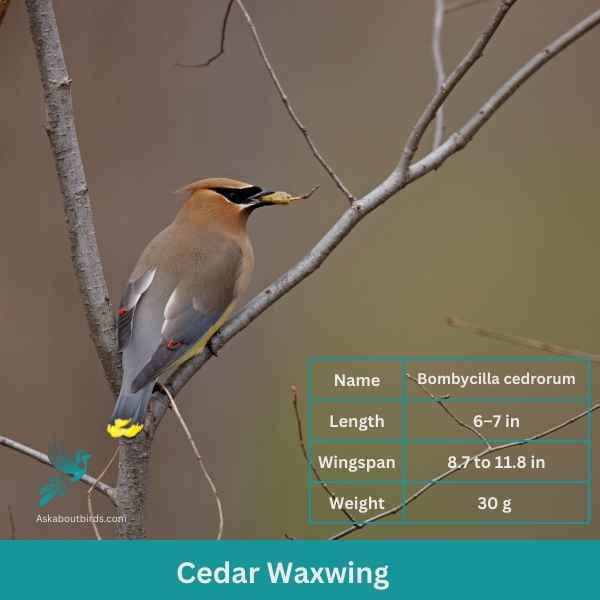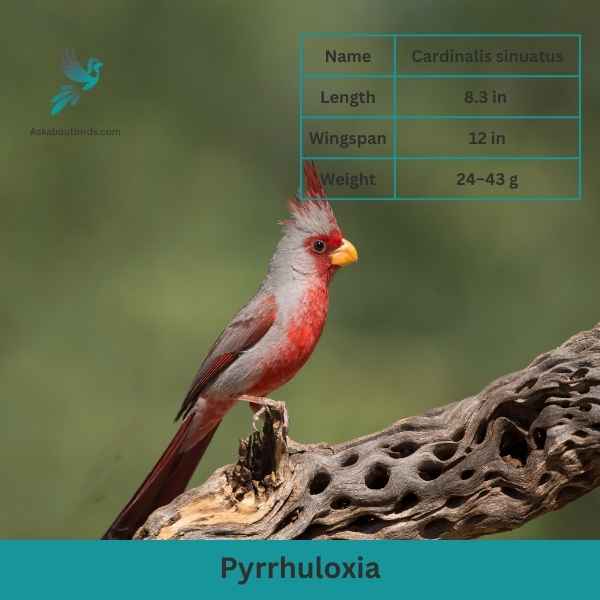Discover the fascinating world of bird look-alikes as we unveil the top common birds that resemble the majestic Cedar Waxwing. From the Bohemian Waxwing’s striking wing patterns to the Northern Cardinal’s vibrant red plumage, these avian doppelgangers will leave you in awe.
List of birds that look like cedar waxwings
- Vermilion Cardinal
- Northern Cardinal
- Bohemian Waxwing
- Phainopepla
- Pyrrhuloxia
Cedar Waxwing


| Feature | Measurement |
|---|---|
| Scientific Name | Bombycilla cedrorum |
| Length | 6 – 7 in |
| Wingspan | 8,7- 11.8 in |
| Weight | 30g |
The Cedar Waxwing is a charming and sociable songbird found in North America. It is known for its sleek and silky plumage, featuring a blend of gray, brownish grey, and yellow tones, with their tails having a bright yellow tip. These birds have a distinctive black mask across their eyes and a small crest on their head, adding to their elegant appearance.
Cedar Waxwings are primarily frugivorous, feeding on a variety of fruits such as berries and soft fleshy fruits. They are often seen in flocks, perched in trees or flying together in coordinated formations. These birds have specialized adaptations, including a unique hooked bill, which allows them to pluck fruits from trees and eat them while in flight.
Vermilion Cardinal


| Feature | Measurement |
|---|---|
| Scientific Name | Cardinalis phoeniceus |
| Length | 7.5 in |
| Wingspan | 9.8 – 12.2 in |
| Weight | 1.5 – 1.7 oz |
for its vibrant red plumage, similar to that of the cedar waxwing. These cardinals typically inhabit semi-arid scrublands, often favoring wooded areas with spiny legumes and cacti.
With their striking red coloration, Vermilion Cardinals add a splash of brightness to their surroundings. They are known for their perching behavior and can be observed sitting prominently on branches or cacti, displaying their vivid plumage. These birds primarily feed on a variety of seeds, fruits, and insects.
Similarities
- Both species are small to medium-sized birds.
- Both have crested heads, which can make their head shapes appear similar.
- They are both Passerine birds.
Differences
- Cedar Waxwings have a distinct black mask around their eyes, while Vermilion Cardinals do not.
- The body coloration is vastly different: Cedar Waxwings have soft, light brown to gray plumage, while Vermilion Cardinals are vibrant red with gray or white undersides.
- The habitats differ – Cedar Waxwings are often found in open woodland areas across North America, while Vermilion Cardinals are found in tropical dry shrubland in Northern South America.
Northern Cardinal


| Feature | Measurement |
|---|---|
| Scientific Name | Cardinalis cardinalis |
| Length | 8.3 – 9.1 in |
| Wingspan | 9.8 – 12.2 in |
| Weight | 1.19 – 2.29 oz |
The Northern Cardinal is an iconic North American bird, easily recognized by its vibrant color and melodious song.
Appearance: Male Northern Cardinals are a brilliant scarlet red, while females display a more subdued reddish olive. Both sexes have a distinctive black ‘mask’ on their face around the bill and a pointed crest on their head. The bird’s beak is robust, cone-shaped, and bright orange in color.
Diet: Northern Cardinals are primarily granivorous, with a diet largely consisting of seeds and grains. They also eat fruits and insects. These birds typically feed off the ground and are frequent visitors to bird feeders.
Reproduction: Northern Cardinals are monogamous, and a pair will breed together for life. The female typically builds a well-hidden nest in a dense thicket or shrub. She lays 2-5 eggs per clutch, which she incubates for around two weeks.
Similarities
- Both species are small to medium-sized and have crested heads.
- They are both Passerine birds.
Differences
- Cedar Waxwings have a soft, light brown to gray plumage and a black eye mask, while Northern Cardinals are either bright red (males) or dull brown (females) with a distinctive face mask.
- Cedar Waxwings are slightly smaller in size compared to Northern Cardinals.
- Northern Cardinals have a more powerful bill adapted for seed-eating, while Cedar Waxwings have a slender bill.
Bohemian Waxwing


| Feature | Measurement |
|---|---|
| Scientific Name | Bombycilla garrulus |
| Length | 7.5 – 9.1 in |
| Wingspan | 12.6 -14 in |
| Weight | 1.9 oz |
The Bohemian Waxwing is a captivating bird species found in North America and parts of Europe and Asia. With a sleek gray body, black mask, and distinctive waxy red tips on its secondary feathers, it has a unique and elegant appearance. The Bohemian Waxwing is slightly larger than the Cedar Waxwing, another species known for its wax-like wing tips.
These birds are often seen in large flocks during the winter months when they congregate to feed on berries. They have a preference for fruit-bearing trees such as mountain ash, hawthorn, and juniper. Their specialized bill allows them to efficiently pluck and consume berries, contributing to their vital role as seed dispersers.
Similarities
- Both species share a similar body size and shape.
- They have crests on their head.
Differences
- Vermilion cardinals have a bright red plumage, while cedar waxwings have a brownish coloration.
- Cedar waxwings lack the black face mask seen in male vermilion cardinals.
Pyrrhuloxia


| Feature | Measurement |
|---|---|
| Scientific Name | Cardinalis sinuatus |
| Length | 8.3 in |
| Wingspan | 12 in |
| Weight | 24–43 g |
The Pyrrhuloxia, also known as the Desert Cardinal, is a medium-sized songbird native to the southwestern United States and northern Mexico. It is closely related to the Northern Cardinal but possesses its own unique characteristics. The Pyrrhuloxia is named after its vibrant red crest and mask-like face markings, similar to that of the Northern Cardinal. However, its overall coloration is more muted, with a grayish body and reddish wings and tail.
Pyrrhuloxias are known for their distinct vocalizations, which include a variety of songs and calls. Males often sing from elevated perches to defend their territories and attract mates. They also engage in aggressive displays to establish dominance.
Similarities
- Both species are small to medium-sized and are Passerine birds.
Differences
- Pyrrhuloxias have a distinctive red crest, breast, and undertail coverts, while Cedar Waxwings have a sleek crested head and overall brownish plumage.
- The bill of a Pyrrhuloxia is thick and yellow, adapted for seed-eating, while Cedar Waxwings have a slender bill.
- Pyrrhuloxias are typically found in the deserts of the southwestern United States and Mexico, while Cedar Waxwings are found in a wider range of habitats across North and Central America.
Phainopepla


| Feature | Measurement |
|---|---|
| Scientific Name | Phainopepla nitens |
| Length | 6.3 – 7.9 in |
| Wingspan | 10 – 12 in |
| Weight | 0.6 -1 oz |
The Phainopepla is a unique songbird known for its striking appearance and its association with desert habitats, particularly those with mistletoe plants.
Appearance: The male Phainopepla has a glossy black plumage with a distinct crest, while the female is gray with a slight crest. Both genders have deep red eyes, adding to their characteristic look.
Diet: Phainopeplas predominantly feed on mistletoe berries. However, they also consume insects, especially during the breeding season, catching them mid-air or picking them off vegetation.
Reproduction: Phainopeplas nest in trees or shrubs. The female lays a clutch of 2 to 4 pale blue eggs. Intriguingly, these birds can breed twice in a year: once in the desert during spring and again in coastal areas during summer.
Similarities
- Both species are small to medium-sized birds.
- They both eat a diet rich in berries and other fruits.
Differences
- Phainopeplas have an entirely different plumage, with males being glossy black and females gray, while Cedar Waxwings have light brown to gray plumage and a black eye mask.
- Phainopeplas have red eyes, which is not seen in Cedar Waxwings.
- Phainopeplas are found in the deserts of the southwestern United States and Mexico, a different habitat from Cedar Waxwings.
10 Fun Facts About Cedar Waxwings
- Unique Crest: Cedar Waxwings (Bombycilla cedrorum) have a unique crest on their head. This small, pointed crest adds to their distinctive appearance.
- Berry-Loving Birds: Cedar Waxwings are known for their fondness for berries. They have specialized adaptations that allow them to digest the high sugar content of fruits.
- Fruity Diet: Cedar waxwings eat consists primarily of berries, such as cherries, mulberries, and juniper berries. They will also eat insects during the breeding season to supplement their diet.
- Social Birds: These birds are highly social and often seen in flocks. They engage in cooperative feeding and breeding behaviors, creating a sense of community among their group.
- Silky Plumage: Cedar Waxwings have silky, smooth feathers that give them a polished and elegant appearance. Their plumage is predominantly brown with a yellow belly and a touch of red on their wings.
- Synchronized Flocking: When foraging for food, Cedar Waxwings often form large flocks that move together in synchronized flight patterns. This behavior helps them locate and exploit fruit sources more efficiently.
- Intoxicated Waxwings: Cedar Waxwings occasionally exhibit drunken-like behavior after consuming fermented berries. The alcohol content affects their coordination, making them more vulnerable to accidents.
- Migratory Birds: Cedar Waxwings are migratory birds, often traveling in flocks during their seasonal movements. They breed in North America and migrate south to areas with abundant food sources during the winter.
- Nesting Habits: These birds build cup-shaped nests in trees or shrubs, using twigs, grass, and moss. They often choose dense foliage near water sources for nest placement.
- Monogamous Pairs: Cedar Waxwings form monogamous pairs during the breeding season. They engage in elaborate courtship rituals, such as passing berries between mates.
FAQS on Birds that look like cedar waxwing
How do you tell the difference between a Cedar Waxwing and a female cardinal?
The Cedar Waxwing and the female Northern Cardinal are two distinct bird species but the female is similar to the cedar waxing. The female Northern Cardinal is a medium-sized songbird with bright red feathers on the wings and tail, while her body is buff-brown. She sports a black mask and a distinctive crest on her head. On the other hand, Cedar Waxwings are known for their sleek, gray wings, and black mask. They exhibit a bright yellow band on the tail and red tips on the wing feathers, which are absent in female Cardinals. Cedar Waxwings also have a crest, but unlike Cardinals, they lack the bright red feathers.
What are the different types of Cedar Waxwings?
There are two species of Waxwings: the Cedar Waxwing (Bombycilla cedrorum), commonly found in North America, and the Bohemian Waxwing (Bombycilla garrulus), which is larger and seen in the Pacific Northwest during the winter. Both species share similar traits, such as sleek gray feathers, red tips on the wings, a bright yellow band on the tail, and a crest on their heads. These beautiful birds are known to travel in large flocks during the breeding season.
What is a GREY bird with a yellow tipped tail?
One common gray bird with a yellow-tipped tail is the Cedar Waxwing. This medium-sized songbird is recognized by its sleek gray wings, black mask, and distinctive crest. The bird’s tail is typically adorned with a bright yellow band at the tip, while the wing feathers have red tips. Cedar Waxwings are commonly seen in North America and are known for their love of berries, which constitute a significant part of their diet.
Other birds with a yellow tip on their tail include the American Redstart, Yellow Warbler, and the Palm Warbler.
Are waxwings a cedar or bohemian?
Waxwings can either be Cedar or Bohemian, these being the two species that belong to the Waxwing family. The Cedar Waxwing is found year-round across North America and is identifiable by its gray wings, distinctive crest, and bright yellow tail tips. The Bohemian Waxwing, larger and more colorful, is typically found in the Pacific Northwest during winter. Both types of waxwings are known to travel in large flocks and primarily eat berries and insects.




